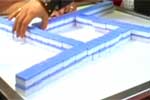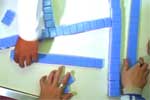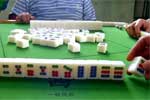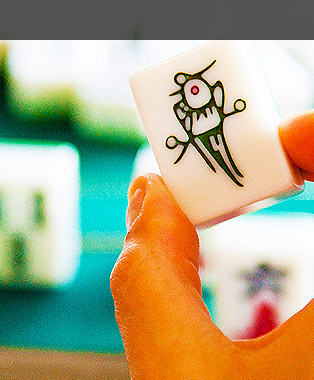Learn to Play Majiang
Majiang has many variations. The following is a general overview of how the Majiang is played.
Seating
One of each of the four wind tiles are placed face-down. The tiles are then shuffled and each player takes one.The players seat themselves according to the draw and in clockwise order of N - W - S - E. East is called the "prevailing wind" and the key position since this player starts, scores double and pays double for the round.
For each subsequent round, the positions change if one of the other winds wins the round, the wind positions rotate in an anti-clockwise fashion so that the player who was South wind in the previous round becomes East wind.
A Majiang session ends when each player has played as the prevailing wind. In some variations, it isn't necessary to complete a whole session - players play for only a set number of rounds or to a target score.
Building the Wall

All the tiles are shuffled thoroughly face down, usually by the player seating on the South and North winds only. This ritual is called "The twittering of the sparrows". Once done, each player takes 34 tiles (2 tiles high and 17 tiles long) and positions them in a wall.
The tiles should have the long sides and be face down. Each wall should lie in front of each player running from left to right. The four walls are then pushed together to form a square symbolizing the Great Wall of China. It is important to ensure that the walls have no gaps and that they touch at the corners so that any lurking dragons or evil spirits are prevented from entering.
Breaking the Wall

Next, the player seating on the East wind throws the dice to decide who breaks the wall. The East wind player counts the number thrown, starting with East and working anti-clockwise. The player who sits where the count ends, throws the dice again and adds the total of both throws and then uses this total to count along his wall from right to left. Where the count ends, is where the player breaks the wall, which is done by removing the pair of tiles at that point and placing the top tile on top of the previous tile and the lower tile in a position two positions further anti-clockwise. These two tiles are called "loose tiles".
Example, if East throws an 11, West will be the chosen player. Then West throws the dice again and if he gets 9, the total will be 20. In which case, West will count along all 17 of the tile pairs in the West wall and then finish on the second pair of tiles in the South wall. West would then remove these two tiles and place the top one on the first (right-most) pair of tiles in the South wall. The lower tile would be placed on the 16th tile in West wall.
Dealing the Tiles
Starting after the break (i.e. continuing in a clockwise direction around the wall), four tiles are dealt to each player in turn starting with East and working anti-clockwise until each player has 12 tiles.
Next, and continuing in the same direction around the wall, the first and third tiles on the top row are dealt to East, the first on the bottom row to South, the next tile on the top row to West and the next lower tile to North. That completes the deal. East finishes with fourteen tiles while the other players have thirteen tiles each.
Majiang Game Play
The first turn, is made by East who discards one tile by placing it face-up inside the remainder of the wall. Each subsequent turn is made by a player taking a tile, optionally playing a tile combination and then discarding a tile. However, which player takes the turn and from where the tile is taken, varies.
After each discard, any player who has 2 or 3 tiles that match the discarded tile may take the next turn by calling Majiang, Pong or Kong. Such a player, takes the discard and plays the resulting Pong or Kong on the table in front of him or, in the case of Majiang, takes the discard and declares all tiles in hand, thus finishing the game.
If no player calls Majiang, Pong or Kong, then the player to the right of the player who just discarded takes the next turn. This player may, if he has 2 tiles that can be matched with the discarded tile to form a Chow, call a Chow. The player must then take the discard and play the resulting Chow.
If a Majiang, Pong, Kong or a Chow has not been called, then the next player in an anti-clockwise direction simply takes a tile from the open end of the wall. If possible and desired, he can then declare a Pong, Kong or Chow by laying the combination face down in front of him.
The player always finishes a turn by discarding one tile and placing it face-up inside the remainder of the wall.
Whenever a Kong is declared, the player must lay all the tiles forming the Kong on the table and immediately take a tile from the Kong Box.
A declared Pong can be converted into a Kong but only using a tile taken from the wall. A Kong can only be made using a discarded tile, if the other three tiles are in hand (concealed).
Tiles that have been discarded, unless they are picked up in the following turn, are dead tiles and take no further part in the game.
Calling "Majiang" (Finishing)

If all the tiles from the wall are drawn, except for whatever remains of the 14 tiles of Kong Box, then the game is declared a draw and no scores are made. The tiles are shuffled again and game is restarted with the same player as East wind.
Once a player has reached the point where a player needs one more tile go out, that player declares "one for Majiang". This alerts the other players to be more careful with their discards and the player in question is said to be "calling" or "fishing".
A player who takes a tile from the wall that makes a completed Majiang hand, declares Majiang and lays down all tiles. Any player who can form a finished Majiang hand with the tile just discarded can call Majiang, take the discarded tile and go out.
It can happen that one player can call Majiang with the discarded tile and another can call Pong or Kong with the discarded tile. In this case the player with Majiang takes precedence. It can also happen that more than one player can make Majiang with the discarded tile. In this case, the player nearest the right of the player who discarded, wins the dispute, takes the tile and goes Majiang.
A player cannot declare a Kong and make Majiang because a replacement tile must always be taken when declaring a Kong. A player cannot declare Majiang and then discard a tile.
In the case where a player takes a tile from the wall and plays it on an already exposed Pong to form a Kong, if another player can use that tile to go out, this player can "Rob the Kong" in order to go Majiang. The player simply takes the tile just played and uses it to play a set of his own tiles to go out. Robbing the Kong is only allowed on exposed Kongs with one exception - a player can Rob a hidden Kong in order to complete the "Thirteen Unique Wonders" special hand.
域名 Majiang.net 正在出售中,如果您对该域名感兴趣,请点击这里提供您的报价。
The domain name Majiang.net maybe for sale. Please click here if you would like to make an offer.



